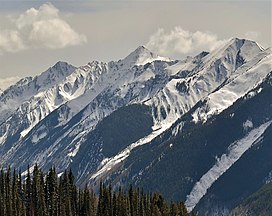|
Hunter Peak
Hunter Peak is a 13,506-foot (4,117 m) mountain summit in Pitkin County, Colorado, United States. DescriptionHunter Peak is located 17 miles (27 km) west of the Continental Divide in the Elk Mountains which are a subrange of the Rocky Mountains. It ranks as the 253rd-highest peak in Colorado.[1] The mountain is situated 10 miles (16 km) south-southwest of the community of Aspen and 4.8 miles (7.7 km) east-southeast of Maroon Bells. The peak is set in the Maroon Bells–Snowmass Wilderness on land managed by White River National Forest. Precipitation runoff from the mountain's slopes drains into tributaries of the Roaring Fork River which is a tributary of the Colorado River. Topographic relief is significant as the summit rises 3,450 feet (1,052 m) above Conundrum Creek in approximately one mile (1.6 km) and 3,700 feet (1,128 m) above East Maroon Creek in 1.5 miles (2.4 km).  EtymologyThe mountain's toponym was officially adopted on October 1, 1930, by the United States Board on Geographic Names at the suggestion of the US Forest Service to honor Gerald M. Hunter (1892–1926), who served as deputy forest supervisor and died while in active service.[2] ClimateAccording to the Köppen climate classification system, Hunter Peak is located in an alpine subarctic climate zone with cold, snowy winters, and cool to warm summers.[5] Due to its altitude, it receives precipitation all year, as snow in winter, and as thunderstorms in summer, with a dry period in late spring. See alsoReferences
External links
|
||||||||||||||||||||||||||||||||||||||||||||


